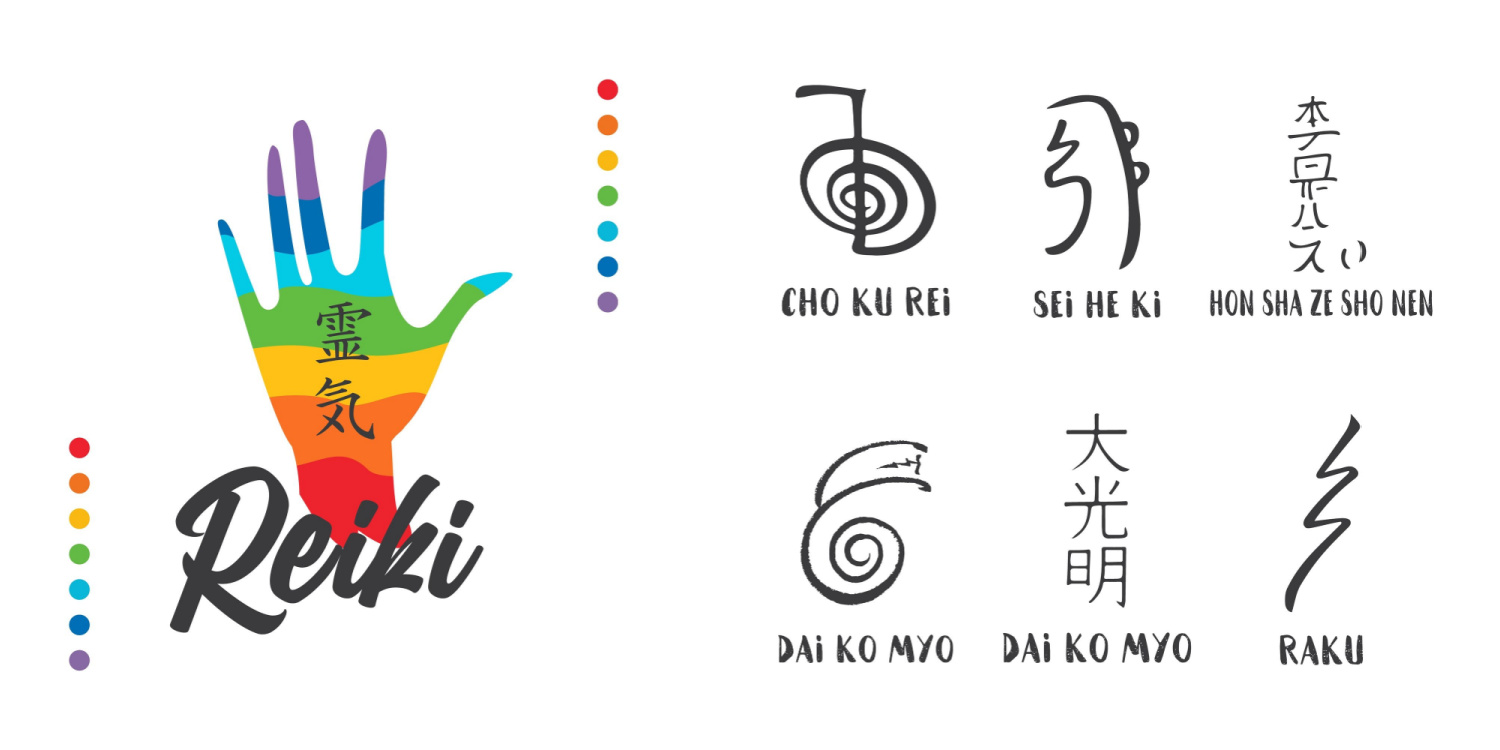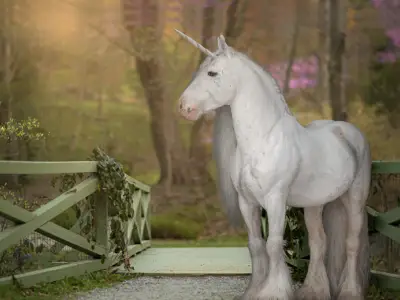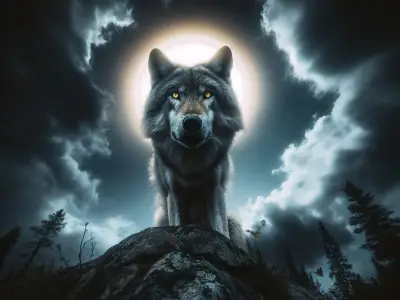Reiki symbols are sacred emblems that are used by Reiki healing practitioners, especially within Usui Reiki, a form of alternative healing that was developed in early 1900s Japan by Mikao Usui. They visually represent the specific energies that can be activated and directed via Reiki.
Jump to:

There are a number of different Usui Reiki symbols, and each has its own unique meaning and purpose. Some of the most common Usui Reiki symbols include:
- Cho Ku Rei: The power symbol. It’s used to increase the power of Reiki, but it also provides protection, grounding, and has the ability to clear energy blockages.
- Sei Hei Ki: The mental/emotional symbol. It’s used to heal emotional and mental problems like anxiety, depression, and addiction.
- Hon Sha Ze Sho Nen: The distance symbol. It’s used to send Reiki energy to someone who’s not physically present, or to connect with past or future events.
- Dai Ko Myo: The master symbol. It’s used to activate the highest level of Reiki energy, and is integral for attunements and to connect with the spiritual realm.
- Raku: The completion symbol. It’s used to ground and settle the body at the end of treatment, sealing all that positive energy inside.
Reiki symbols can either be used together or separately to achieve different healing goals. It's important to remember that, while Reiki healing symbols are an important part of this holistic practice, they are not necessary for Reiki healing. The symbols don’t hold any special power of their own, and are primarily intended as teaching tools. They serve to show someone how to change the way that Reiki energy (also known as “qi” or “chi”) is already functioning. The most important part of Reiki healing is the intention and energy of the practitioner; the symbols merely add to this!
Here are some common Reiki symbols with images:
The “Cho Ku Rei” Reiki Symbol
Translated as: “Placing all the power of the Universe here, now.”
Looks Like: A straight line at the top and a spiral at the bottom.
When to Use: At the beginning of a Reiki session, as it helps practitioners to connect with the universal life force energy.
How It’s Used: Simply by drawing the symbol in the air or visualising it in their mind's eye, a Reiki practitioner can activate the energy of Cho Ku Rei and direct it to wherever it’s needed. The direction that the symbol is drawn in determines whether it’s being used to increase or decrease power. It’s sometimes thought of as “a switch”. By visualising the symbol around themselves or a client, a practitioner can create a barrier of positive energy that repels negative energy and protects against psychic attacks.
The Cho Ku Rei symbol is one of the most powerful Reiki level 2 symbols. It can be used to clear energy blockages, balance the chakras or simply focus your attention. By drawing the symbol over a specific chakra or area of the body, a practitioner can activate a stronger flow of energy that boosts healing.
The “Sei Hei Ki” Reiki Symbol
Translated as: "God and man become one."
Looks Like: A backwards "Z" (reminiscent of the Raku symbol), the number "5", and an arc with two bubbles.
When to Use: Any time.
How It’s Used: By visualising the symbol over the affected area or drawing it on a piece of paper (perhaps even placing it under a pillow), a Reiki practitioner can activate the healing energy of Sei Hei Ki to promote emotional and mental wellness. This symbol is often used to bring together the conscious and subconscious minds, helping to heal emotional and mental issues. It releases negative emotions, like anger, fear and anxiety, and also improves emotional balance and mental clarity. It can even be used to help treat addiction issues or cases of depression.
As an added benefit, the Sei Hei Ki symbol can help to balance the left and right sides of the brain, unlocking enhanced levels of creativity, intuition, and spiritual growth.

The “Hon Sha Ze Sho Nen” Reiki Symbol
Translated as: “Without past, present or future.”
Looks Like: A complex symbol with a large number of brush strokes in Japanese Kanji characters.
When to Use: Any time.
How It’s Used: Often used for distance healing, visualising this Reiki 2 symbol helps a practitioner to send Reiki energy through time and space, promoting healing and inner peace. The Hon Sha Ze Sho Nen symbol can also be used to help heal past traumas, release the negative energy that lingers from these past experiences, and to connect with deceased loved ones.
Furthermore, the Hon Sha Ze Sho Nen symbol can be used to help balance the energy of different parts of the body, or to allow someone to connect with different aspects of their self (such as the inner child or past lives) to achieve spiritual growth. All the practitioner has to do to activate this healing energy is to draw the symbol over the affected area or visualise it in their mind's eye. Lastly, this symbol can also serve as a key to the Akashic records: sometimes thought to be the source of all human consciousness.
The “Dai Ko Myo” Reiki Symbol
Translated as: “Great Shining Light.”
Looks Like: Another complex symbol, with straight or curved lines radiating like a sun from the middle. The Tibetan variant instead looks like a central spiral, two larger spirals on either side, and a horizontal line that connects them.
When to Use: Any time.
How It’s Used: The most sacred, powerful and complex symbol in Reiki practice, the Dai Ko Myo helps someone to connect with divine energy and access their spiritual zenith. It’s often used to help promote spiritual growth, enlightenment, and foster a closer connection with the divine. In a sense, Dai Ko Myo also heals the healer who uses it!
Visualising the Dai Ko Myo symbol and directing the resulting Reiki energy to a target area can allow a practitioner to assist with physical healing, emotional and mental balance, and to clear energy blockages. This symbol also has the power to activate and enhance the other Reiki symbols, amplifying their healing energy to create an especially powerful healing session.
The “Raku” Reiki Symbol
Translated as: “Fire serpent."
Looks Like: A jagged lightning bolt.
When to Use: During the final stage of the Reiki attunement process.
How It’s Used: A Master Level Reiki symbol, Raku is not a traditional Reiki symbol, but rather has been created by some Reiki practitioners as a part of their personal practice. Its meaning and use can therefore vary somewhat. Some practitioners use Raku as a grounding symbol, relying on it to connect with the earth's energy and promote a sense of stability and balance. It often has the dual purpose of allowing the body of the patient to receive the benefits of Reiki energy, and clearing the practitioner of any negative energy that they’ve absorbed during a treatment session (or to shield themselves from negative energy or psychic attacks).
The Raku symbol can also be used as a symbol of completion or release, helping an individual to let go of old patterns, habits, or emotions that no longer serve them. By visualising the symbol and intending for it to help release old patterns or energies, the practitioner can promote inner peace and emotional balance. Raku is usually drawn from head to ground, and can also be used in isolation amid the hustle and bustle of daily life to bestow a moment of grounding.
Study Reiki 1 & 2 for £29
On the other hand, if you’re considering adding Reiki to your existing skill set as a holistic practitioner, then our Reiki 1 & 2 Diploma Course serves as a comprehensive introduction to the practice. Available for just £29 via the links in this blog, it covers what you need to get set up, and go on to become a Reiki Practitioner, before then taking your skill set even further with our Reiki Master Teacher Course.





